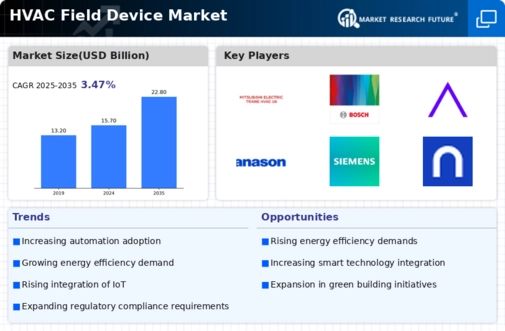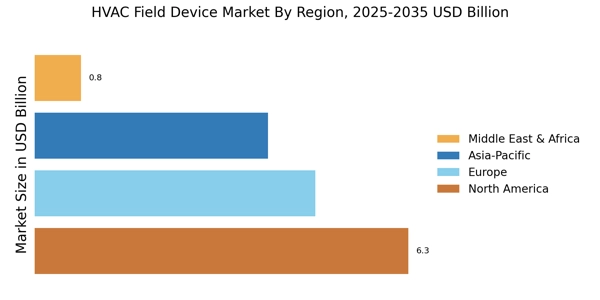Regulatory Pressures and Standards
Regulatory pressures and standards are increasingly influencing the HVAC Field Device Market. Governments and regulatory bodies are implementing stringent regulations aimed at reducing greenhouse gas emissions and promoting energy efficiency. Compliance with these regulations is becoming essential for manufacturers, as non-compliance can result in significant penalties and loss of market access. As a result, companies are investing in research and development to create HVAC field devices that not only comply with existing regulations but also anticipate future standards. This proactive approach is likely to drive innovation and competitiveness within the HVAC Field Device Market, as companies strive to meet and exceed regulatory expectations.
Growth of Smart Building Initiatives
The growth of smart building initiatives is significantly impacting the HVAC Field Device Market. As urbanization continues to rise, there is a growing emphasis on creating smart, connected buildings that optimize energy use and enhance occupant comfort. HVAC systems are central to these initiatives, and the demand for smart HVAC field devices is increasing as a result. These devices facilitate seamless integration with building management systems, allowing for centralized control and monitoring. The smart building market is projected to expand rapidly, with HVAC systems playing a crucial role in this transformation. This trend is likely to drive further innovation and investment in the HVAC Field Device Market, as stakeholders seek to capitalize on the benefits of smart technology.
Increased Focus on Indoor Air Quality
The HVAC Field Device Market is witnessing an increased focus on indoor air quality (IAQ), driven by growing awareness of health and environmental concerns. Consumers are becoming more conscious of the impact of air quality on health, leading to a demand for HVAC systems that can effectively filter and purify indoor air. This trend is prompting manufacturers to innovate and develop advanced filtration systems and air quality monitoring devices. According to industry reports, the market for air quality monitoring devices is expected to grow significantly, as more consumers prioritize health and wellness in their living and working environments. This shift is likely to propel the HVAC Field Device Market forward as companies adapt to meet these evolving consumer needs.
Technological Advancements in HVAC Systems
Technological advancements are playing a pivotal role in shaping the HVAC Field Device Market. The integration of IoT, AI, and machine learning into HVAC systems has led to the development of sophisticated field devices that enhance operational efficiency and user experience. These technologies enable real-time monitoring and predictive maintenance, which can significantly reduce downtime and operational costs. For instance, smart thermostats and sensors are becoming increasingly prevalent, allowing for precise control over heating and cooling systems. The market for smart HVAC devices is projected to grow at a compound annual growth rate of over 10% in the coming years, indicating a robust shift towards technology-driven solutions in the HVAC Field Device Market.
Rising Demand for Energy-Efficient Solutions
The HVAC Field Device Market is experiencing a notable surge in demand for energy-efficient solutions. As energy costs continue to rise, consumers and businesses alike are increasingly seeking systems that minimize energy consumption while maximizing performance. This trend is reflected in the growing adoption of advanced HVAC field devices that incorporate smart technologies and automation. According to recent data, energy-efficient HVAC systems can reduce energy usage by up to 30%, which is a compelling incentive for both residential and commercial sectors. Consequently, manufacturers are focusing on developing innovative devices that not only meet but exceed energy efficiency standards, thereby driving growth in the HVAC Field Device Market.

















Leave a Comment